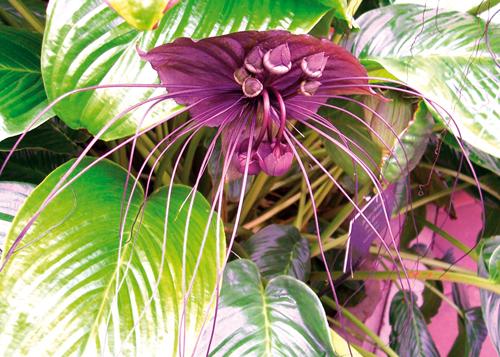The B-list: Exotics and also rans – Phuket Gardening

PHUKET: Barleria, bixa, begonia, bismarkia, bromeliad, brownia, brugmansia, brunfelsis. What do all these words have in common – apart from the obvious fact that each word starts with the letter B?
Well, dear Phuket Gazette reader, of course, you got it in one. They are all tropical plants. Moreover, once you get away from these Latin-based botanical names, the list grows at the rate of tropical bamboo – that is to say, rapidly; banana, bat plant, balsam, bird’s nest fern, buttercup tree, busy lizzie, bachelor’s button, Buddha’s belly, bird of paradise, boxwood beauty – many with evocative names that help us both to visualize and remember the plant in question.
Some of these can be rapidly glossed over since they have been considered in previous articles or simply don’t match our key criterion of plants that will be at home in a Phuket garden. The bat plant (tacca chantrieri) is a case in point. I have never grown it and have only once seen the devil flower (to give it yet another evocative and picturesque moniker) in a local nursery. It gets its bizarre name from flowers (actually bracts) that are purplish black in color and resemble a large moth or bat. Long thin filaments hang down from these bracts. Hence yet another name – cats’ whiskers. These flowers appear above clumps of low-growing, lush, glossy green leaves .
Even if you do manage to discover a specimen, you will need to tend it carefully. The bat plant does not appreciate an overdose of sun and needs rich, moist soil of the kind not readily available in Phuket. As a member of the edible arrow root family, mature plants can be propagated by root cuttings – if you get that far.
The bird of paradise plant is another temperamental exotic with a tongue-twisting name to match –strelizia. As a native of slightly cooler climes with a less consistently humid atmosphere, it may struggle in Southern Thailand, but if you can get it to thrive here, it will reward you with a magnificent display of extraordinary orange and blue flowers. The flowers last a long time: this helps to explain the fact that they are more likely to be spotted here as dramatic displays of cut flowers in high-end resorts and spas. S. regina is the most widely grown: S. nicolai is much larger with clusters of long oval leaves and blue and white flowers. It looks fantastic when planted as a massed bed – as I once saw in a hillside garden above Chalong where conditions suited it down to the ground. The bird of paradise can be grown from seed or by planting tubers. But it may take up to seven years to bloom. Quite a wait.
From the sublime strelitzia to the humble barleria is quite a step. Small, relatively insignificant, easy to grow, this plant comes into the category of “useful” additions to your garden. It is relatively low-growing and is one of those shrubs – like the duranta or dwarf ixora – that will take any amount of clipping. Indeed, pruning will encourage a bushier growth. For this reason, barleria is often used as a low hedge or barrier.
B. cristata, the commonest variety, has tubular mauve flowers and foliage that is dark green with paler undersides. It is a ruderal species, colonizing disturbed areas and roadsides. It likes full sun but will flourish in most soils. A spiny variety, sometimes called B. prionitis, has yellow or orange flowers and reddish brown stems; B. repens has flame red flowers. Untemperamental, barleria can be easily grown from cuttings.
Tip of the week – Kumquat care
The kumquat is an Asian member of the citrus family. Because it is hardier than the conventional orange (it can tolerate frost), and because it makes a small, compact bush, it is often grown as a container plant. The small orange fruits (either round or oval) have a sweet rind (which can be candied) and sour pulp. The foliage is an attractive glossy green. Kumquats are very resistant to disease.
A friend has a cherished potted specimen which he tells me is apparently dying. Unusual, because they are tough cookies. They do, however, go through a period of dormancy every year when they appear to be lifeless, and produce no new foliage or fruit, but they will normally start up again after a few weeks. Over-watering or feeding during this period is likely to prove terminal.
If you have a question, or a garden that you would like featured, you can email Patrick Campbell here.
Keep checking our online Phuket Lifestyle pages, follow us on Twitter @phuketgazette or join our Facebook fan page for regular gardening features and tips.
— Patrick Campbell
Latest Thailand News
Follow The Thaiger on Google News:


























